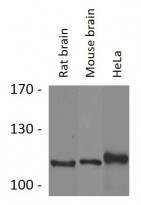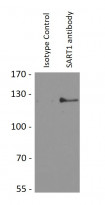ARG59594
anti-SART1 antibody
anti-SART1 antibody for IHC-Formalin-fixed paraffin-embedded sections,Immunoprecipitation,Western blot and Human,Mouse,Rat
Overview
| Product Description | Rabbit Polyclonal antibody recognizes SART1 |
|---|---|
| Tested Reactivity | Hu, Ms, Rat |
| Tested Application | IHC-P, IP, WB |
| Host | Rabbit |
| Clonality | Polyclonal |
| Isotype | IgG |
| Target Name | SART1 |
| Antigen Species | Human |
| Immunogen | Recombinant fusion protein corresponding to aa. 1-255 of Human SART1 (NP_005137.1). |
| Conjugation | Un-conjugated |
| Alternate Names | allergen Hom s 1; Snu66; Ara1; hSnu66; U4/U6.U5 tri-snRNP-associated 110 kDa protein; U4/U6.U5 tri-snRNP-associated protein 1; SNU66 homolog; Squamous cell carcinoma antigen recognized by T-cells 1; HOMS1; hSART-1; SART1259; SNRNP110; SART-1 |
Application Instructions
| Application Suggestion |
|
||||||||
|---|---|---|---|---|---|---|---|---|---|
| Application Note | * The dilutions indicate recommended starting dilutions and the optimal dilutions or concentrations should be determined by the scientist. | ||||||||
| Positive Control | Rat brain, Mouse brain and HeLa | ||||||||
| Observed Size | 120 kDa |
Properties
| Form | Liquid |
|---|---|
| Purification | Affinity purified. |
| Buffer | PBS (pH 7.3), 0.02% Sodium azide and 50% Glycerol. |
| Preservative | 0.02% Sodium azide |
| Stabilizer | 50% Glycerol |
| Storage Instruction | For continuous use, store undiluted antibody at 2-8°C for up to a week. For long-term storage, aliquot and store at -20°C. Storage in frost free freezers is not recommended. Avoid repeated freeze/thaw cycles. Suggest spin the vial prior to opening. The antibody solution should be gently mixed before use. |
| Note | For laboratory research only, not for drug, diagnostic or other use. |
Bioinformation
| Database Links | |
|---|---|
| Gene Symbol | SART1 |
| Gene Full Name | squamous cell carcinoma antigen recognized by T cells 1 |
| Background | This gene encodes two proteins, the SART1(800) protein expressed in the nucleus of the majority of proliferating cells, and the SART1(259) protein expressed in the cytosol of epithelial cancers. The SART1(259) protein is translated by the mechanism of -1 frameshifting during posttranscriptional regulation; its full-length sequence is not published yet. The two encoded proteins are thought to be involved in the regulation of proliferation. Both proteins have tumor-rejection antigens. The SART1(259) protein possesses tumor epitopes capable of inducing HLA-A2402-restricted cytotoxic T lymphocytes in cancer patients. This SART1(259) antigen may be useful in specific immunotherapy for cancer patients and may serve as a paradigmatic tool for the diagnosis and treatment of patients with atopy. The SART1(259) protein is found to be essential for the recruitment of the tri-snRNP to the pre-spliceosome in the spliceosome assembly pathway. [provided by RefSeq, Jul 2008] |
| Function | Plays a role in mRNA splicing as a component of the U4/U6-U5 tri-snRNP, one of the building blocks of the spliceosome. May also bind to DNA. [UniProt] |
| Cellular Localization | Nucleus. Note=Found in the nucleus of mitogen-activated peripheral blood mononuclear cells (PBMCs), tumor cells, or normal cell lines, but not in normal tissues except testis and fetal liver or in unstimulated PBMCs, suggesting preferential expression in proliferating cells. [UniProt] |
| Calculated MW | 90 kDa |
| PTM | Sumoylated with SUMO2. [UniProt] |
Images (2) Click the Picture to Zoom In
-
ARG59594 anti-SART1 antibody WB image
Western blot: 25 µg of Rat brain, Mouse brain and HeLa cell lysates stained with ARG59594 anti-SART1 antibody at 1:1000 dilution.
-
ARG59594 anti-SART1 antibody IP image
Immunoprecipitation: 150 µg extracts of Jurkat cells immunoprecipitated and stained with ARG59594 anti-SART1 antibody at 1:1000 dilution.







